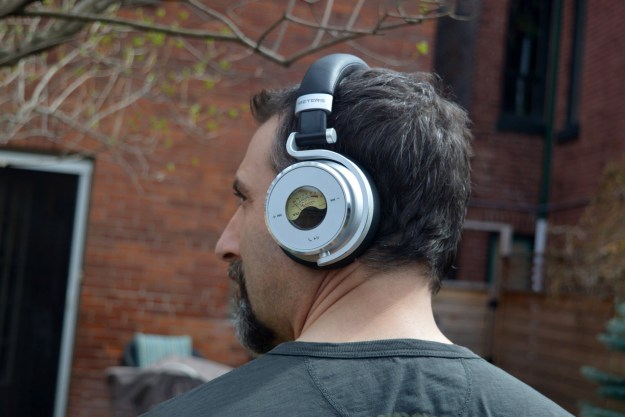“The Grado SR125s provide the best rock, acoustic, and vocal quality we have heard, but suffer in most electronic categories.”
- Crisp
- punchy sound
- Uncomfortable
- unsightly
- slip easily
Summary
The Grado SR125s provide the best rock, acoustic, and vocal quality we have heard, but suffer in most electronic categories. Mild distortion was heard on the lower end, but the overall quality of the sound was great, including for gaming. The overall design of these headphones cannot be ignored. They lack in almost every category imaginable: comfort, material quality, adjustability, aesthetics, etc.
Forward:
In our earlier review of the Sennheiser HD580s, we addressed two issues associated with headphones, particularly the Grado v. Sennheiser differences in sound, and the need for an amp for true audiophile quality.
Introduction:
“First, there appears to be a divide in the audiophile headphone community with many people falling into either the Sennheiser or Grado side. Both manufacturer high quality headphones with unique characteristics and this review is not meant to be a comparison or ranking of the HD580s in comparison to other offerings. It is a standalone, hands on review discussing the use of the
The first thing we noticed about the Grado SR125s was the stark contrast in type of sound produced compared to the Sennheisers. Sound was much crisper, bordering on abrupt, rather than allowing sounds to blend to create an environment. Each sound is separated from every other, and the rising and falling edges of each sound were sharp. This made for less atmosphere, but more punch to abrupt sounds, hence the ‘punchy’ sound.
Features and design:
The design of these cans, quite simply, couldn’t be worse. In fact, they performed well technically, but we could not overlook the lack of design. Adjusting them consists of bending the metal headband to the desired tightness, and sliding the earpieces up and down a metal stick that creates bug-like antennas if you have a smaller head. The plastics feel flimsy, and the fact that movement of each headphone piece is restricted by contact with these plastic pieces, does not inspire confidence in the longevity of the product. The medium density phone used to the ear pads feels abrasive, and just barely surrounds the ear. Unfortunately, this styling graces the entire Grado line. If you like their sound, you will want to modify them for comfort and maintain your pride in public.
The Grado SR125s are dynamic, open air, over-the-ear headphones. The soundstage is medium to narrow, and midfield to close distance, which adds to the impact felt during abrupt transitions. They use a 1/4″ plug, so you will need a 3.5mm adapter if you intend to use this with a PC or portable player.
Use and testing:
Our music selection for auditioning included:
Bjork’s “Vespertine” (DVD-Audio, MP3)
Mahler Symphony 10 (Berliner Philharmoniker – conducted by Sir Simon Rattle – DVD-Audio)
The Cure “Bloodflowers” (CD, MP3)
David Bowie “Heathen” (CD, MP3)
Diamanda Galas “Malediction and Prayer” (CD, MP3)
Portishead “Portishead” (CD, MP3)
Aphex Twin “Drukqs” (CD, MP3)
(All MP3s encoded with VBR 160kbps-300 kbps/44kHz.)
Played through:
– SoundBlaster Audigy 2 Platinum (for DVD-Audio, CD, and MP3)
– iRiver SlimX 350 (CD and MP3)
– Yamaha RX-V2200 receiver w/ Pioneer DVD player using digital out (DVD-A, CD)
– Rio PSA|Play 120 (MP3)
At first we thought this would be great for techno, and electronic music with quick transitions in sound, but instead sounds appeared so divided, the stereotypical ‘beep boop beep’ image of techno was all we could think of. By shortening the sound length, sounds were easier to localize, and thus made this music very repetitive. Also, extremely low frequencies caused some crackling in Aphex Twin tracks like “gwely memans”.
Classical music sounded good. Nothing groundbreaking, but no distortion. With the close soundstage was not ideal, but playing with EAX settings were able to push it back some (EAX environments were disabled for all tests but this one).
Rock and other acoustic music sounded extremely good. In this category, they outperformed the Sennheiser HD580s easily. Very impactful, and highly recommended for this type of music. We couldn’t resist the chance to play Diamanda Galas through such sharp headphones. The Grado SR125s followed every odd shriek and fluctuation in voice perfectly. If you like spoken word, the details of voices come through clear and coherent.
Acid Jazz fell halfway between the Rock and techno. Voices sounded excellent, but the sound was too sharp for instrumental portions of the music.
For gaming, the SR125s performed very well, since the crisp sound allowed for good specialization. Soundtracks to games suffered slightly, but sound effects had good kick and were well placed. Unfortunately, a one hour session became painful because of the comfort factor.
Conclusion:
The Grado SR125s provide the best rock, acoustic, and vocal quality we have heard, but suffer in most electronic categories. Mild distortion was heard on the lower end, but the overall quality of the sound was great, including for gaming. The overall design of these headphones cannot be ignored. They lack in almost every category imaginable: comfort, material quality, adjustability, aesthetics, etc.
Design Rating: 3/10
Technica Rating: 8.5/10
Editors' Recommendations
- Samsung S95C OLED hands-on review: it’s time to get excited
- The absolute best tech we reviewed last month
- New tech could mean pint-sized Klipsch speakers with massive sound
- Samsung S95B OLED hands-on review: Brilliant potential
- Google Pixel Buds A-Series hands-on review: Same buds, way better price




